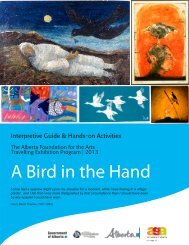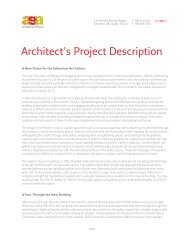Down on the Farm - Art Gallery of Alberta
Down on the Farm - Art Gallery of Alberta
Down on the Farm - Art Gallery of Alberta
- No tags were found...
You also want an ePaper? Increase the reach of your titles
YUMPU automatically turns print PDFs into web optimized ePapers that Google loves.
The <strong>Alberta</strong> Foundati<strong>on</strong> for <strong>the</strong> <strong>Art</strong>s Travelling Exhibiti<strong>on</strong> ProgramPhotography: The Modern View: A Surveyc<strong>on</strong>tinuedc<strong>on</strong>sidered music abstract by nature as it does not try to represent <strong>the</strong> exterior world but ra<strong>the</strong>rto express in an immediate way <strong>the</strong> inner feelings <strong>of</strong> <strong>the</strong> human soul. He was also influenced by<strong>the</strong> <strong>the</strong>ories <strong>of</strong> Theosophy expressed by H.P. Blavatsky. These <strong>the</strong>ories, which had atremendous influence <strong>on</strong> many artists during <strong>the</strong> 1920s, postulated that creati<strong>on</strong> was ageometrical progressi<strong>on</strong> beginning with a single point. Kandinsky’s mature paintings focus <strong>on</strong>geometric forms and <strong>the</strong> use <strong>of</strong> colour as something aut<strong>on</strong>omous and apart from a visualdescripti<strong>on</strong> <strong>of</strong> an object or o<strong>the</strong>r form and through relinquishing outer appearances he hoped tomore directly communicate feelings to <strong>the</strong> viewer.The most radical abstracti<strong>on</strong>ist <strong>of</strong> <strong>the</strong> early 20thcentury was Piet M<strong>on</strong>drian (1872-1944). Born inAmersfoort, <strong>the</strong> Ne<strong>the</strong>rlands, M<strong>on</strong>drian began hiscareer as a primary teacher. While teaching he alsopracticed painting and <strong>the</strong>se early works, whiledefinitely representati<strong>on</strong>al in nature, show <strong>the</strong>influence various artistic movements such aspointillism and fauvism had <strong>on</strong> him. M<strong>on</strong>drian’s art,like Kandinsky’s, was also str<strong>on</strong>gly influenced by <strong>the</strong><strong>the</strong>osophical movement and his work from 1908 to <strong>the</strong>end <strong>of</strong> his life involved a search for <strong>the</strong> spiritualknowledge expressed by <strong>the</strong>osophist <strong>the</strong>ory.Piet M<strong>on</strong>drianCompositi<strong>on</strong> with Yellow Patch, 1930Kunstsammlung Nordrhein-Westfalen, DusseldorfIn 1911 M<strong>on</strong>drian moved to Paris and came under <strong>the</strong> influence <strong>of</strong> Picasso’s cubism. Whilecubist influences can be seen in his works from 1911 to 1914, however, unlike <strong>the</strong> CubistsM<strong>on</strong>drian attempted to rec<strong>on</strong>cile his painting with his spiritual pursuits. In this pursuit he beganto simplify elements in his paintings fur<strong>the</strong>r than <strong>the</strong> cubists had d<strong>on</strong>e until he had developed acompletely n<strong>on</strong>-representati<strong>on</strong>al, geometric style. In this work M<strong>on</strong>drian did not strive for purelyrical emoti<strong>on</strong> as Kandinsky did. Ra<strong>the</strong>r, his goal was pure reality defined as equilibriumachieved through <strong>the</strong> balance <strong>of</strong> unequal but equivalent oppositi<strong>on</strong>s. By 1919 M<strong>on</strong>drian beganproducing <strong>the</strong> grid-based paintings for which he became renowned and this subject motivatedhis art practice for <strong>the</strong> rest <strong>of</strong> his life.AFA Travelling Exhibiti<strong>on</strong> Program, Edm<strong>on</strong>t<strong>on</strong>, AB. Ph: 780.428.3830 Fax: 780.421.0479youraga.ca
















